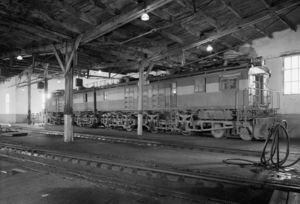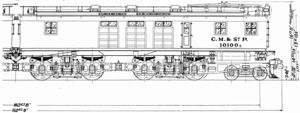Milwaukee Road class EP-1, EF-1, EF-2, EF-3, and EF-5
The Chicago, Milwaukee, St. Paul and Pacific Railroad (Milwaukee Road) classes EP-1 and EF-1 comprised 84 boxcab electric locomotives built by the American Locomotive Company (ALCO) in 1915. Electrical components were from General Electric. The locomotives were semi-permanently coupled back-to-back in pairs, and numbered as a pair with 'A' and 'B' suffixes. As built, 30 pairs were assigned to freight service, classified as EF-1. The remaining twelve pairs were assigned to passenger service as class EP-1, with higher-speed passenger gearing. The design was highly successful, replacing a much larger number of steam locomotives, cutting costs and improving schedules.
In 1919, with the arrival of a newer generation of passenger power, the EP-1 locomotives were converted to EF-1 freight locomotives. In this role, they served until the 1950s, when the arrival of the Little Joe locomotives began to replace them in freight service.
Technical information
They were fitted with multiple-unit train control systems, and could thus be joined together into larger sets and operated from a single control station.
The two powered trucks were connected together with a ball-and-socket joint, and the couplers were also attached to the trucks. The bodywork, therefore, did not take the load of the train. Each truck had outside bar frames, allowing more room for the traction motors and equipment. The front powered truck's frames extended forward and carried an outrigger truck and the heavy snowplows the units bore.
Each driven axle was powered by two motors geared to it, in similar manner to successful later designs such as the PRR GG1.
EF-2, EF-3 and EF-5
In the 1930s, with train tonnage increasing, the Milwaukee began to create three-unit locomotives out of the boxcab units. A simple combination of three was classified EF-2. Twenty-four such combinations were assembled. On these, the cab on the center unit was unnecessary and just added weight and length. Twelve more units were therefore shortened by removing the cab, the pilot truck and the frame extension; these were nicknamed "bobtails". These were assembled in between two standard units to create twelve EF-3 sets.
Later, some four-unit locomotives were created; these were classified EF-5 and could have any combination of regular or bobtail units in the center two positions.
EP-1A
In 1950, two EF-1 locomotives, E22A/B and E23A/B were converted back into passenger service as class EP-1A to help the aging Bi-Polars on the Puget Sound Extension. E22 received some smoothing of its appearance, including somewhat "streamlined" cab fronts. They were repainted into the Union Pacific Railroad scheme of Armor Yellow with Harbor Mist Gray roofs, and red dividing lines. These two locomotives served until the 1960s in this role; at some point, the units of E23 became center units of a 4-unit E22.
Today
Unit E50 A&B, the first locomotive built, still survives and is preserved at the Duluth Transportation Museum in Duluth, Minnesota. Unit E57B, which was used as a singleton switcher at Harlowton, Montana, is now preserved there
References
- Chamberlin, Clint. Milwaukee Data 5. North East Rails. Retrieved on 2006-01-05.
| Electric locomotive classes of the Milwaukee Road |
|---|
| EF-1 · EF-2 · EF-3 · EF-4 (Little Joe) · EF-5 · EP-1 · EP-2 (bi-polar) · EP-3 (quill) · ES-1 · ES-2 |



